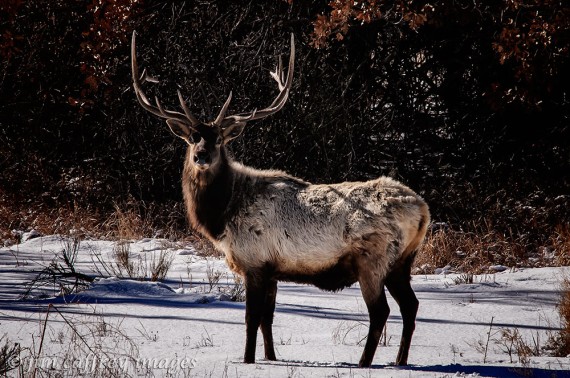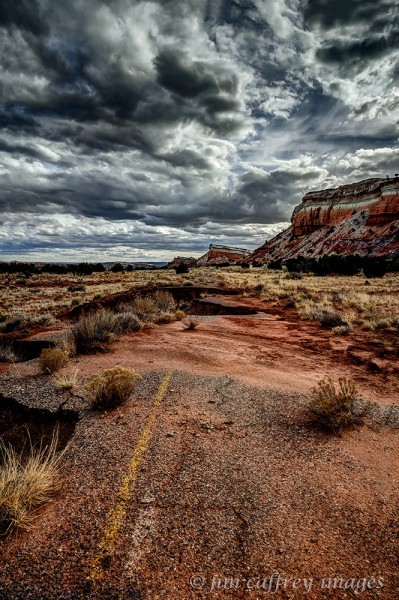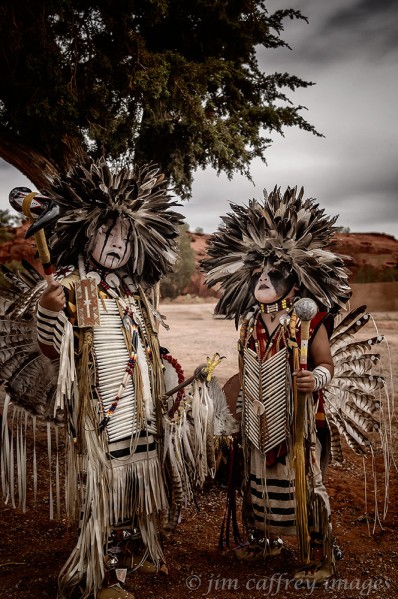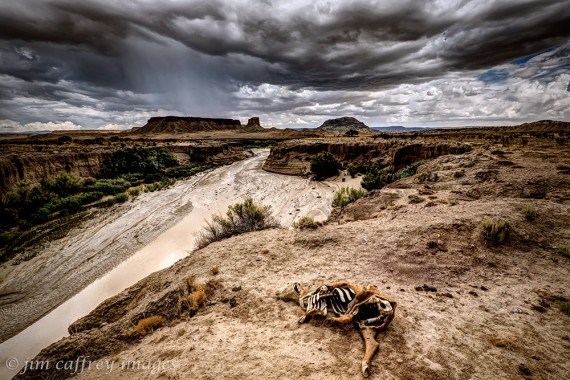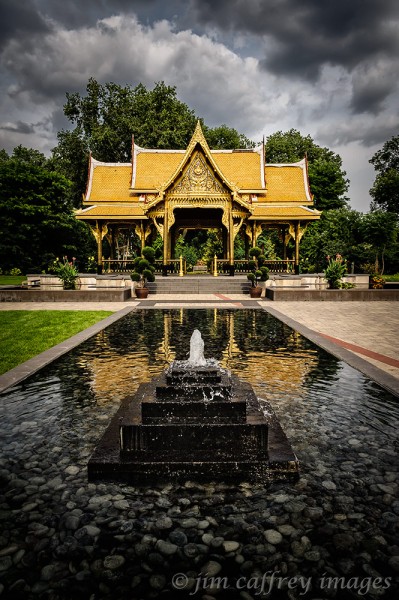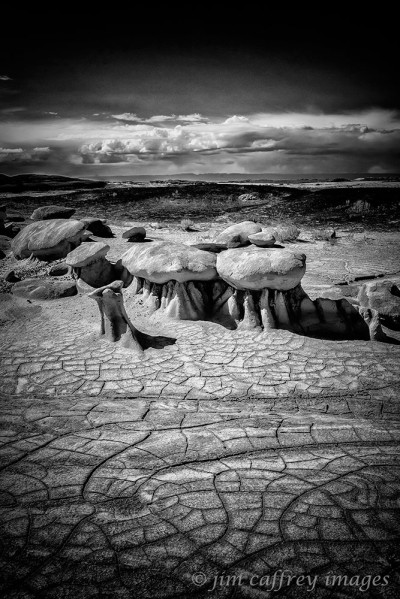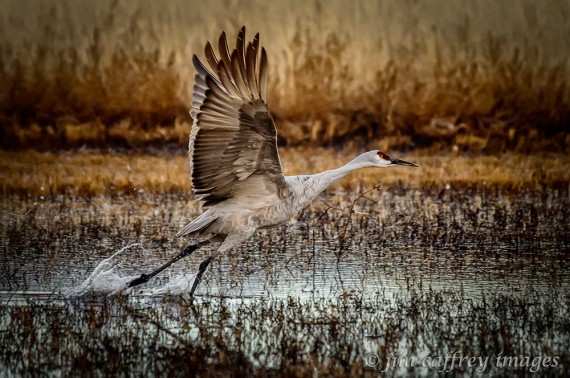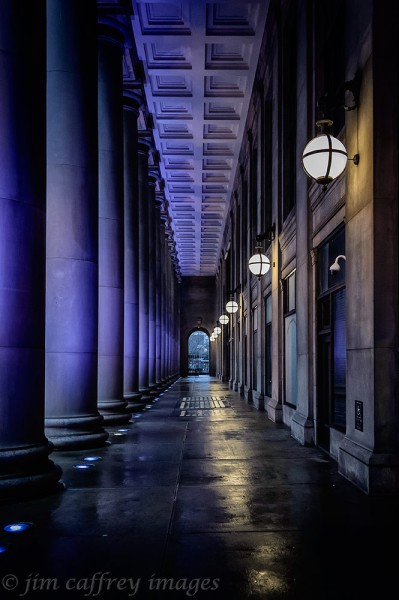In The Yard
I have mentioned in some of my previous posts that I do a lot of driving to make photographs, and while that’s certainly the case, there are times when the images come to me. I live in a cabin on a river in north central New Mexico, so it’s not uncommon to see wildlife on my land. I use a long lens when photographing wildlife both for their comfort and my safety, but, long lenses aside, there have been times when I have gotten quite close to my subjects.
This doe was browsing along the edge of my road and she posed for me as I drove by. I like the contrast of the gourds along the bottom edge of the frame and the sere grasses in the background.
Nikon Df Nikkor 24-120mm F6.3 1/125
There are several bucks that frequent the area where I live. They use my property as a corridor to access the river. They are a part of a family which also include as many as eight does, their fawns and an ever-changing number of yearlings. As is typical with mule deer, the males only congregate with the females and young during the rut. For the remainder of the year, they live a mostly solitary existence.
Nikon D500 Sigma 150-600 F8 1/800
I made this photograph in late September. Mule deer coats become darker, a greyish brown, going into the winter months. You can see the difference in color if you compare this with the previous image. I’m pretty certain it’s the same individual in both photos.
Nikon D500 Nikkor 80-400 F8 1/160
When the males are young, they sometimes travel in small bachelor groups. These two showed up together regularly through the summer, but as fall arrived, they went their separate ways.
Nikon D500 Sigma 150-600 F8 1/500
This bull elk is a frequent visitor. Here he is in early March looking pretty rough after a hard winter. His fur is matted and almost mangy looking; his antlers have just begun regrowing after shedding those of the previous year.
Nikon D 500 Nikkor 200-500 F 8 1/500
A month and a half later, the same bull is looking much better with a healthier coat and a sizable spread on his antlers. Being in such intimate contact with these animals always leaves me with a sense of wonder and privilege.
Nikon D500 Nikkor 200-500 F8 1/400
Roaming The San Juan Basin-Part 2
My previous post: Roaming The San Juan Basin-Part 1, was about the first day of a two-day road trip through the expanse of a great bowl shaped depression in the middle of the Colorado Plateau in northwest New Mexico. I spent Saturday night in Farmington and awoke early on Sunday. I had planned to head straight home from there, but as I prepared to leave, I thought better of it and decided to do some more exploring. As I drove up the road that leads from Farmington to the edge of the basin, I began to formulate a plan. I decided that I would avoid any of my normal haunts: the Bisti Wilderness, Ah Shi Sle Pah, etc. and that I would try to stay on dirt or gravel roads as much as possible. With this blog post in mind, I also decided to take a photojournalistic approach to making my images as opposed to my usual process.
I left the paved road about forty miles south of Farmington and immersed myself in the rolling, broken landscape. The San Juan Basin has numerous drainages of all sizes that carve the washes and valleys that form the irregular surface and expose the long buried geological features. I turned south on a road I knew would take me past Ah Shi Sle Pah…forbidden territory on this trip. I noticed three abandoned dwellings off to the west. The walls were of rock; the roofs, non-existent or barely there. They had a melancholy look to them; it was as though they were being swallowed by the great expanse that surrounded them.
A few miles further along the road, I saw a band of horses; one group of seven animals, and a mare and foal off by themselves. I stopped the car and walked to the side of the road to set up my tripod and the larger cluster immediately moved farther away from me. I made a few exposures and decided I would try to get closer, but the horses ran to the edge of the wash while the closest one–a stallion and probably the alpha–stood his ground and began to snort and pound the ground with his hoof. From this behavior, I surmised that this was a wild band; the tame horses I have encountered are typically friendly and will even approach to within an arm’s length.
I took the hint and returned to the car. I didn’t want to alarm the animals any more than I already had. I didn’t make it more than a half mile further when I spotted a smaller group of three white horses on the south side of the road. These were more friendly, but still more stand-offish than usual. They continued their grazing, but were wary of my presence.
Now I dropped down into Kimbeto Wash, a key drainage for this part of the San Juan Basin. I came to a tee in the road; to the left, Ah Shi Sle Pah, to the right, unknown territory. I turned right and crossed Kimbeto Wash. Less than a quarter mile further along was a road to the left and a sign: Chaco Canyon miles. The mileage was illegible. Onward.
I was excited to find a back way into Chaco; connecting the dots on a map has always been satisfying for me. The road crossed a grassy plain with a low mesa on the southern horizon. The only other visible feature was a lone hogan about a hundred yards off the road to the west. After about ten miles there was a sharp left turn and the track dipped down and crossed Chaco Wash before continuing up to the top of a high plateau.
By now, I was firmly into a spontaneous wandering frame of mind; I took a turn onto a two-track that seemed to lead to the plateau’s edge, but the road curved back and dead-ended at an abandoned homestead, complete with old cars and trash burn barrels. I’ve seen hundreds of these forlorn dwellings scattered across the remote desert areas I frequent. They always put me in a pensive mood.
Back on the main road, I soon came to an intersection that put me on the main road into Chaco Canyon. I decided to make a quick tour of the loop.
One of the most interesting elements of the ancient pueblo culture for me is the kiva. There are different kinds of kivas: many were used as places for social gathering, but most of them were ceremonial in nature. These adjacent kivas at Chetro Ketl–the second largest pueblo complex in Chaco Canyon–were used for religious ceremonies. Standing near these centuries-old subterranean enclosures made me feel connected to the ones who contrived and built these amazing communities.
Chaco Canyon is actually comprised of many pueblo complexes which were built over a span of four centuries and housed thousands of permanent residents and visitors from outlying sites. Of these complexes, Pueblo Bonito is the largest with more than eight hundred rooms. Like most of the pueblos in Chaco Canyon, Pueblo Bonito is built close against the wall of the mesa.
A little further along the loop road from Pueblo Bonito is Pueblo del Arroyo. It is situated along the edge of Chaco Wash and had three hundred rooms; it is thought to have been built by residents of Pueblo Bonito who moved due to overcrowding in the larger site.
I had already spent more time at Chaco Canyon than I wanted to, so I made for the exit that brought me to Hwy 57 heading south. As I passed the boundary I stopped to make a photograph of Fajada Butte which rises 440 feet above the canyon floor and is home to the most famous of all the Chaco sites: The Sun Dagger site. Three slabs of rock are set up and arranged in such a way that shafts of sunlight shine through them and onto specific parts of a petroglyph carved on the rock wall of the butte on each of the solstices and eqinoxes. More proof that these early Americans were far more advanced than the “savages” they have been depicted to be.
So, with these thoughts bouncing around in my head, I left Chaco behind and continued my exploration of the San Juan Basin. New Mexico State Road 57 is not what you might expect from the designation. Soon after it starts at US 550 between Huerfano and Nageezi, it sheds its asphalt coat and becomes a dirt road in the truest sense of the word. A good rain will quickly turn it into a quagmire of greasy clay, the kind that will defeat even the most serious four-wheel drive vehicle.
So, although I truly enjoy a good thunderstorm, I couldn’t help but hope that the building thunderheads would hold their water at least until I made it to the pavement of Indian Rte. 9 twenty-five miles to the south. I was about half way between Chaco and the paved road when over a rise in the road came two beautiful horses. One of them, a mare, turned sideways in the road and seemed to be bowing to me. I was enchanted; I spent over half an hour with them and when I finally left them behind, it was with some reluctance.
The remainder of the drive on NM 57 was relatively uneventful. There were a few small clusters of hoodoos and several small herds of livestock and then, suddenly I was at the intersection with the paved road. I looked back the way I had come, again with some reluctance, and then turned onto Indian Rte. 9. Almost immediately I came across three horses drinking from a water barrel. The scene seemed to say a good deal about the nature of this remote area, so I made a photograph of it.
After its intersection with NM 57, Indian Rte. 9 climbs onto a low mesa and emerges at Pueblo Pintado, an outlier of the pueblos at Chaco Canyon. This area is still inhabited by the descendants of the anasazi people, but now they live in houses scattered across the mesa in the shadow of the ruin that was their ancestral home. Another thirty miles brought me to Torreon. It is here that IR 9 becomes New Mexico 197 and turns northeast towards Cuba, NM. I turned onto an un-numbered, but paved road that runs from Torreon to the small village of San Luis in the Rio Puerco Valley. I passed a rock ruin that I had photographed before, but I stopped to make several exposures before continuing on towards San Luis.
As I drew near San Luis and the Rio Puerco Valley, a heavy thunderstorm passed ahead of me, nearly obscuring the volcanic monolith of Cabezon Peak. It seemed a fitting end to my adventure. Even as I neared home my mind began wandering and wondering about another dirt road I had noticed meandering into the vastness of the San Juan Basin…
Horsein’ Around
What promised to be a day of amazing atmospheric conditions and light came with an unexpected bonus during a recent trip to the Rio Puerco Valley. Those of you who are familiar with my work know that this is one of my favorite locations.
We were looking for something a little different, but, after all, how often can you visit one place and expect to come up with something fresh? I made a turn onto a side road that I had driven past many times; it headed off across a low mesa toward the double peaked Cerro Cuate. Out of nowhere came a small herd of horses. We could see by their brands that they were not wild. Their gregarious nature confirmed it.

One horse in particular took to Robin and she was enchanted.
As we wandered around the fringes of the band, they went about their business. These three stuck together and moved a short distance away from the two more friendly members of the group. Although I am no expert on horses or their behavior, I’m pretty sure they are mares.
I was amazed by the relaxed, friendly demeanor of these gentle animals. They are obviously used to being around people. These two struck a familial pose for me.

With the volcanic neck of Cabezon as a backdrop, these two males (I didn’t get close enough to be able to tell if they are stallions or geldings) proceeded to play with each other as if they were showing off.
In all, we spent about forty-five minutes with our new-found friends working the horses as I would a model in a portrait shoot. I was looking for something as I photographed and when I saw this frame I realized that this was it.
My Few Of My Favorite Things
Wow! Another year fades into memory. I have spent the last couple weeks editing the images I’ve made in 2013 with the goal of culling my favorite dozen. Image editing for me is a labor of love; I have a connection to my work, so picking “the best” out of hundreds candidates is not an easy task.
I knew from the time I made this photo of a bull elk in my yard on January 3rd that I was setting a high standard for the rest of the year. Also, not only was it serendipitous, but the image was a departure from my usual wide angle landscapes. I had been feeling for some time that my work had been stagnating, so I resolved then and there to take it in a new direction.
In early February, I ventured into an area along US 550 that I had been looking at as a shooting location for some time. I was drawn by some red sandstone pinnacles that were visible from the highway. As I walked toward them, I came across this old section of road that is slowly eroding, being reclaimed by natural forces. The scene made me realize how impermanent our impact on nature really is. In the end, this is the image that stood out above the others I made that day. Again: serendipity.
As the year progressed, I found myself revisiting some places I had been before. The image of the church on San Ildefonso Pueblo (a scene I had driven past countless times before) is more about the light than the subject matter. It is also a more visually compressed image than is usual for me due to my use of a longer focal length lens.
Every year at the end of May–Memorial Day Weekend to be exact–the Pueblo of Jemez hosts the Starfeather Pow Wow. Hundreds of native dancers from across the country come to dance and compete. I made hundreds of images that weekend, but this portrait of two brothers stood out. They are dressed in “dog soldier” head-dresses, hair-pipe breastplates, and feather bustles, all made by their father. Just before I released the shutter, I told them to give me some attitude. I think they did a pretty good job.
Anyone who is familiar with my work, knows that I spend a great deal of time in the Rio Puerco Valley. It was near the middle of July and the rains had just started after several months of searing heat and cloudless skies when I made this image. There are many possible causes for this animal’s demise, but the location of its desiccated remains along a now rain-filled wash and the rain falling from a heavy sky tells an ironic story about the uncertainty of life in this harsh environment.
And speaking of harsh environments, the Bisti Wilderness in July can be a sobering place. The temperatures can soar to well over 100°F. I usually try to discourage clients from booking a photo tour during this time, but if the monsoons have started, it can be relatively pleasant and the cloudy skies lend a sense of drama to the scene. I made this image of one of my clients pondering the maze in the Brown Hoodoos section of the wilderness.
From a land of parched earth to a place where water is omni-present; my travels took me to Wisconsin in August. On a day-trip to Olbricht Botanical Gardens with my daughter, I made this image of the Thai Pagoda. Normally I steer clear of this kind of symmetry in a photograph, but the structure, and the entire environment seemed to demand it.
Autumn is the best time to be in the badlands, especially if the atmosphere cooperates. Even though the ground was soft and the washes were running from the rain, there were still cracks in the earth. It was as though the soil had a memory of the scorching it normally receives and refused to let go. After processing this image, I realized that it was best to convert it to black and white.
During the months of September and October I spent a great deal of time photographing the trains of the Cumbres-Toltec narrow-gauge railroad which runs from Chama, New Mexico to Antonito, Colorado. I spent every weekend for nearly a month chasing the trains and the fall colors. In the end, my favorite image had nothing to do with color and everything to do with the train, the track and the trestle.
To most people, in the US anyway, November means thanksgiving. For me it is my annual trip to Bosque del Apache National Wildlife Refuge. Over the years, I have come to relish my time with the cranes, herons, geese, and other waterfowl that call the Bosque home during the winter months. Even though I have thousands of images of the birds flying, taking wing, landing, wading, eating, and doing whatever else it is that they do, I still managed to make two of my favorites there in 2013.
This first is obvious and familiar: a crane in the process of taking off from one of the ponds to fly to the fields where he will spend the day foraging. The second is a departure from my normal Bosque images, but one that illustrates the reason that I keep returning year after year.
In December I travelled by train to visit my oldest daughter (an adventure I wrote about in my previous blog entry). Chicago’s Union Station was a surprise to me. I made several images inside the station and when I wandered out the doors to Canal Street, I found this scene. I was immediately drawn by the fact that while some of the elements had symmetry–there’s that word again–some didn’t. And of course the cherry-on-top: the wet pavement reflecting the lights and columns.
In My Yard
I live in a small village in north-central New Mexico and the Jemez River runs through my yard. There is one apple tree; I don’t harvest the apples. In the fall when they begin to ripen, the deer make my yard their own and feast on the apples.
They also come through to get to the river. There is a drainage that runs from the mesa top five hundred feet above and the deer use this as a conduit to move to and from the river which is the most reliable source of water for miles.
The deer: bucks, does, and fawns have become a regular source of enjoyment for me. Just looking out and seeing them browsing at the tree or grazing in the grasses gives me a sense of connection to them and their world–my world.
Last week while editing some images and trying to pick one to post to my Facebook page, I went to my coffee pot to pour a cup, then to the door to survey the yard. I was greeted by this majestic bull elk. There are plenty of elk in the Jemez Mountains and I’ve seen many on, or near the road, especially in the high country; but this was the first time I had seen one in my yard. He was nervous and I had to move slowly to get into position to get a decent line of sight.
I managed to make eight exposures and the two I have posted here are my picks. I hope this guy makes my place a regular stop in the future.
Black and White, Toning, and Split Toning
When you convert an image to black and white, your creative options don’t end there. There are several ways to convey the mood of a black and white image, and strangely they involve color. Anyone who is interested in presenting their photographs in black and white should begin by learning the best way to make the original conversion. Perhaps the most direct method is to convert the image to grayscale using the command in the Image dropdown menu in Photoshop, but easiest is not always best. Before I go any further, let me acknowledge that there are many image editing applications out there, but for the sake of simplicity and because Adobe Lightroom and Photoshop are the applications I use, I will limit this discussion to those two.
A much better way to make your conversions is to add a Black and White adjustment layer in Photoshop, or if you’re working in Lightroom, use the B&W conversion tab in the Develop module. In either case, you will get a series of sliders which include all the colors in the spectrum from red to magenta. By using these sliders, you can adjust the tone of each color as they appear in black and white. In other words, you have much more control over the contrast and tonal range of your monochrome image.
If you want to take your image a little further, you can tone it by checking the tint check box in the B&W adjustment panel in Photoshop. In Lightroom, you can apply the toning by using the Split Toning panel in the Develop module. The image above has a sepia tone applied to it. I normally use at least a small amount of toning on all of my black and white conversions, but if I want to convey a certain feeling, I will use more saturation in the toning. I normally use either a sepia or a selinium tone, but you are not limited to these; you can choose any hue across the spectrum.
Finally, you have the option of doing a split tone. This is done by choosing a tone for the highlights and one for the shadows. There is no option for split toning in Photoshop. It must be done in either Lightroom or Adobe Camera Raw. Using the sliders in the Split Toning panel, you can adjust the hue and the saturation for each of the tones you choose. The above image has a very slight yellowish tone in the light areas, and a bluish (selinium) tone in the darker areas. I chose to use a split tone for this portrait to add a little more visual contrast and interest in the horse’s face.
This last image is one that I used in a recent post. I am re-posting this color version for comparison.
 I chose to make a sepia toned B&W conversion and I think this does a better job of conveying the feeling of melancholy that I had when I first encountered this scene.
I chose to make a sepia toned B&W conversion and I think this does a better job of conveying the feeling of melancholy that I had when I first encountered this scene.
So, the next time you find yourself wondering if your image might look better in monochrome, take some control over the process. You may come away pleasantly surprised.
Shiprock-The Big Plug
New Mexico is a geologic wonderland. Much of the earth is laid bare by erosion, both wind and water sculpt the land removing the softer material and leaving the harder stuff to stand as enormous monuments to a time long past. Shiprock in the northwestern corner of the state is what remains of a volcano that erupted about twenty-seven million years ago. It now stands at a height of nearly sixteen hundred feet above the flatlands which surround it. The monolith is sacred to the Navajo people and it plays a large part in some of their creation stories.
I made this first image as we approached Shiprock from the west. I saw this as a great addition to my byways project; it also puts Shiprock in perspective in relation to its surroundings. The plain stretches for miles in all directions and the great volcanic plug is virtually the only-and certainly the biggest-thing to break the horizon.
As we got a little closer, there was a herd of ponies grazing peacefully with Shiprock in the background. Close by stood a trailer with a small addition. I assume these horses belong to whomever lives there. What a great backyard!
This last image was made after we drove through the breech in the largest lava dike. It is one of six that run for miles in all directions away from the central column. These dikes were underground lava tubes at the time of the eruption, they now stand high above the ground, like Shiprock itself, exposed by time and the elements




























